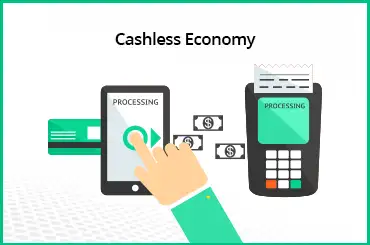Under the IGST Act, the information on the place of supply under GST is critical to comply with one's GST responsibility and tax calculations and to abide by the legislation. The entire supply of services and goods in India from the manufacturer to the consumer is subject to GST. Goods and Service Tax or GST is a comprehensive destination-based tax that includes credit for input taxes spent at each phase.
Various rates, varying from 0% to 28%, are applied to the tax, with the actual rate that varies according to the type of goods or services. GST has streamlined the taxation system that has also supported the economy's expansion.
In this article, we have provided an in-depth understanding of the place of supply under GST, its importance for businesses, the rules for determining the place of supply, its impact on GST, and the importance of complying with the place of supply rules. So stay tuned to know more on this subject!
Definition of Place of Supply Under GST
The phrase "place of supply under GST" refers to the area where a specific supply of goods or services is thought to have occurred when determining the relevant GST and the state in which it is required to be paid. It's a key aspect of GST that businesses use to assess their tax obligations.
Importance of Determining the Place of Supply
Businesses must establish the place of supply to fulfill GST laws and regulations for the following reasons:
- Proper knowledge enables firms to establish their actual GST liability and the state where it must be remitted.
- An erroneous assessment might result in GST overpayment or underpayment, including fines and interest.
- The place of supply additionally establishes whether the transaction is intra-state or inter-state, which has an impact on the applicable GST rate along with the kind of GST that must be paid.
- The precise place of supply identification assists firms in understanding and receiving input tax credits and lowering total tax obligations.
- Moreover, to save tax payments and avoid compliance issues, it's crucial for firms to determine the place of supply appropriately.
Different Types of Supplies and Their Place of Supply
Given that there are distinct GST laws and regulations based on the place of supply for goods and services and types of supplies, let's understand the role of types of supply and place of supply.
-
Goods: Whether the supply is an inter-state or intra-state transaction determines the place of supply for the commodities. Goods include:
-
Essential Goods and Services on which GST is low.
-
Standard Goods and Services on which a standard rate of GST is charged.
-
Special Goods and Services include precious metals and luxury items on which a high rate of GST is charged.
-
Services: Various services that come under GST are:
-
Contract services.
-
Consultancy services.
-
Professional services, like chartered accounting professionals, advocates, doctors, architects, dentists, engineers, teachers, designers, and film artists.
-
Courier services.
-
GST rate for information technology or IT services-management consulting, business consulting, design and development, hosting services, IT infrastructure services, and other IT services.
-
Educational services, training services by coaching centers.
-
Internet telecommunication services-online audio or video content, online content services, online books, and newspapers.
-
Maintenance, and repair installation services like office furniture, computer, telecom equipment, radio, and tv equipment.
-
Other IT services include research and development in computer sciences, telephone-based support, and other IT services.
Rules for Determining Place of Supply
General Rule
The location where goods are supplied plays a crucial role in establishing a company's tax liability because different locations have different tax rates that may apply. You need to understand the rules to determine the place of supply for goods since it's crucial for all businesses to abide by the law, thereby ascertaining the tax obligations accurately.
The general rule for identifying the place of supply under GST is where the products or services have been supplied. In other words, when there is a movement of goods, where the buyer and supplier are involved, the place of supply is the place of delivery of goods to the recipient. The place of supply in the case of services is the location of the service recipient.
However, the place of supply may change depending on elements like the supply's nature, the supplier's or recipient's location, and the location of the actual performance. Businesses must precisely ascertain the GST rules for place of supply to follow the law and calculate their tax obligations.
Place of Supply for Goods
Whether a supply is an intra-state or inter-state transaction determines the place of supply for products under the GST.
- Intra-State Transactions: If the commodities are delivered within the local state, the transaction becomes intra-state whereas the supplier's location serves as the place of supply, and CGST & SGST will be charged.
- Interstate Transactions: The recipient's address serves as the place of supply in an interstate transaction where commodities are sent to another state and in this case, IGST will be charged.
- In cases where goods are assembled or installed at the buyer's location, the place of supply is the buyer's site.
- When goods are shipped to the buyer by the seller on behalf of the third party, then the place of business of the third party is considered as the place of business.
Place of Supply for Services
- Location of Service Recipient: As per the rule, in the case of services, the place of supply is the place of the service recipient. This applies if the recipient is also registered under GST.
- Location of Service Provider: However, if the service is provided to someone who is not registered under GST, the place of supply is the recipient's place provided his address is on record else the service provider's location is taken as the place of supply.
- Place of Actual Performance: The place of supply is where the service is provided if carried out at a particular place.
- Special Cases: The place of supply is decided depending on particular guidelines in several exceptional scenarios. These consist of the following:
- Services related to immovable property: Immovable property services are provided at the place of supply, where the immovable property is located.
- Transport of products: The location where the goods are delivered for transportation is the place of supply.
- Services offered on board a conveyance: The place of supply is the conveyance's initial scheduled location for departure, according to the services offered on board.
- Banking firms, financial institutions, non-banking financial companies, or NBFCs' services: The recipient's account is located at the place of supply.
- Services rendered by a telecommunications provider: The recipient of the services is located at the place of supply.
Place of Supply in Specific Scenarios
Inter-State Supplies:
The recipient's location is the place of supply for the inter-state supplies under GST of products or services. On these transactions, the recipient is obligated to make payment for the Integrated Goods and Services Tax (IGST). However, the place of supply may be established according to special regulations for some goods and services. For instance, the location where the items are delivered for transportation is known as the place of supply for transportation services.
Intra-State Supplies:
The place of supply is called the location of the supplier of the products or services in this instance of intra-state supplies under GST. Based on whether the supply falls within a state or union territory, the supplier must pay State Goods and Services Tax, i.e., SGST, the Central Goods and Services Tax, i.e., CGST, or Union Territory Goods and Services Tax, i.e., UTGST on such transactions.
Exports and Imports:
In the case of imports, the importer's location is the place of supply and IGST is charged. In the case of exports, the place of supply is located outside India. Since there is no GST on exports, GST on exports is refunded.
E-commerce Transactions:
The place of supply in e-commerce transactions under GST is decided by considering the type of transaction. The place of supply is the supplier's location when the e-commerce provider only acts as a supply conduit. Assuming the e-commerce owner is the provider, the place of supply is the operator's location.
Impact of Place of Supply on GST
A. Calculation of GST:
The place of supply directly impacts the GST calculation. It determines the applicable tax rate, and the transaction's taxable worth is computed per that determination. The tax rate could change depending on whether the transaction is intra-state or inter-state. Firms must accurately identify the place of supply to effectively estimate their GST liability.
B. Payment of GST:
The place of supply also influences the payment of GST. For intrastate supplies, the supplier needs to pay CGST, SGST, or UTGST based on the place of supply, whereas IGST is due for interstate goods. The GST calculation and payment must be carried out by the deadlines specified to prevent interest or penalties.
C. Input Tax Credit:
The availability of ITC, i.e., Input Tax Credit under GST, is also influenced by the place of supply. Businesses claim ITC on the GST paid on purchases only when the supplies have been utilized for business purposes. The ITC, nevertheless, may only be utilized to offset IGST liability in the context of interstate supplies. In order to successfully claim the ITC, firms must correctly identify the place of supply.
D. Filing of GST Returns:
Filing GST returns is also impacted by the place of supply. Businesses must file GSTR-1, and GSTR-2 reports for the supplies they make and receive accordingly. The place of supply must be reported correctly to guarantee appropriate taxable value and GST liability reporting. Rejection of refunds or penalties may result due to inaccurate reporting.
Importance of Complying With Place of Supply Rules
Complying with the place of supply rules under GST is significant due to many reasons:
Avoidance of penalties:
It is crucial to abide by the place of supply regulations for avoiding penalties under GST or to avoid any fines or legal repercussions. Your returns may be rejected, input tax credits may be blocked, or penalties may be assessed when you break these regulations.
Building trust with customers:
Building trust with customers under GST requires adhering to the place of supply regulations. Customers anticipate businesses to be open and to follow all applicable laws. Businesses can reassure their clients of their commitment to openness and compliance by abiding by the place of supply guidelines.
Ensuring seamless business operations:
Maintaining smooth business operations requires adherence to the place of supply regulations. An inaccurate place of supply might result in inaccurate GST liability computation, blocking of the input tax credit, or return rejection. These may impede business operations, incur extra expenses, and cause delays.
Stay Compliant With Place of Supply Under GST Regulations
As the GST landscape evolves, changes in legislation or international agreements may impact the rules governing the place of supply. Businesses should stay updated with any amendments to ensure accurate determination of the place of supply, which will enable proper tax compliance and avoid potential penalties.
Adapting to future developments in the place of supply regulations will be essential for businesses to effectively navigate the ever-changing GST landscape and maintain seamless operations in domestic and international transactions. TranZact supports businesses towards this purpose with its cloud-based production and inventory software that enables businesses to develop GST-compliant invoices with all essential fields effortlessly!
FAQs on Place of Supply Under GST
1. After completing a transaction, can firms alter the place of supply?
No, the place of supply can't be modified after the transaction has been completed; it must be decided upon beforehand.
2. What part does the place of supply play in calculating the input tax credit?
The place of supply evaluation determines if companies are eligible for an input tax credit. It assesses the GST paid on the products and services utilized for business operations.
3. Can the Place of Supply alter between intra-state and inter-state transactions?
Yes, the place of supply can vary between intra-state (within the same state) and inter-state (across different states) transactions under GST. The rules for determining the place of supply differ depending on the nature of the transaction.
4. How do the GST computation and payments depend on the Place of Supply?
The computation and payments of GST are closely tied to the place of supply. The place of supply establishes the jurisdiction of taxation for that transaction as well as the applicable GST rate.
















